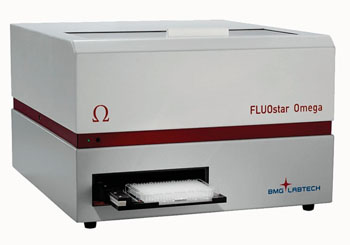New Assay Improves Detection Of Deadly Prion Diseases
By LabMedica International staff writers
Posted on 28 Apr 2016
Transmissible spongiform encephalopathies (TSEs), or prion diseases, are a family of rare progressive, neurodegenerative illnesses that affect both humans and animals and TSE surveillance is important for public health and food safety.Posted on 28 Apr 2016
Because TSEs have the potential of crossing from animals to humans, as seen with the spread of mad cow disease, or bovine spongiform encephalopathy (BSE), an advanced assay that offers better sensitivity than currently available tests for detecting a prion disease is essential.

Image: The FLUOstar Omega microplate reader (Photo courtesy of BMG Labtech).
Scientists at the Lethbridge Laboratory (AB, Canada) studied elk brains from animals suffering from chronic wasting disease, a prion disease that affects cervids, which are hoofed ruminant mammals in the deer family, as the model for the assay. Surveillance programs rely on highly sensitive diagnostic methods to detect infections early. Addressing the need to define steadfast analytical performance criteria for prion amyloid seeding assays (ASAs), they developed a method to measure prion protein conversion time (from normal cellular form to prion form) by a combination of statistical analyses to obtain a prion-detecting ASA with a known degree of confidence.
The timed prion seeding assay (tASA) is an in vitro method that mimics the conjectured mechanism of prion propagation in vivo. It is a conversion assay that uses recombinant prion-related protein as a substrate and detects conversion via changes in fluorescence. The team described time specifications for the assay to help avoid false-positive results (30 hours) or false-negative results in weakly positive samples (48 hours), as well as the number of replications necessary for adequate sensitivity (two to 12). The assay is analyzed on a FLUOstar Omega microplate reader (BMG Labtech, Ortenberg, Germany).
They compared the sensitivity of the new assay technique, the tASA to other currently available tests: two bioassays in laboratory rodents and three commercially available TSE rapid tests. The three regulatory-approved TSE rapid test platforms were the Prionics Check WESTERN (Thermo Fisher Scientific, Waltham, MA, USA); the Bio-Rad TeSeE enzyme-linked immunosorbent assay (ELISA, Hercules, CA, USA); and the IDEXX HerdChek CWD enzyme-linked immunoassay (EIA, IDEXX, Westbrook, ME, USA).
The investigators were able to define clear cut-off criteria, allowing determination of TSE-positive and TSE-negative states. Unlike TSE rapid tests, ASAs also have the potential to detect and measure TSE infection in blood, saliva, or urine. This would offer clinical advantages, such as the ability to sample blood instead of relying on more invasive tissue biopsy and to screen blood donations for contamination.
John G. Gray, MS, the lead author of the study said, “We found that the tASA was at least as sensitive as two rodent bioassays and up to 16 times more sensitive than three different TSE rapid tests. We believe this methodology represents the future for prion diagnostics, especially concerning human health, for example in screening blood donations.” The study will be published on April 8, 2016, in The Journal of Molecular Diagnostics.
Related Links:
Lethbridge Laboratory
BMG Labtech
Thermo Fisher Scientific
Bio-Rad Laboratories
IDEXX







 Analyzer.jpg)






